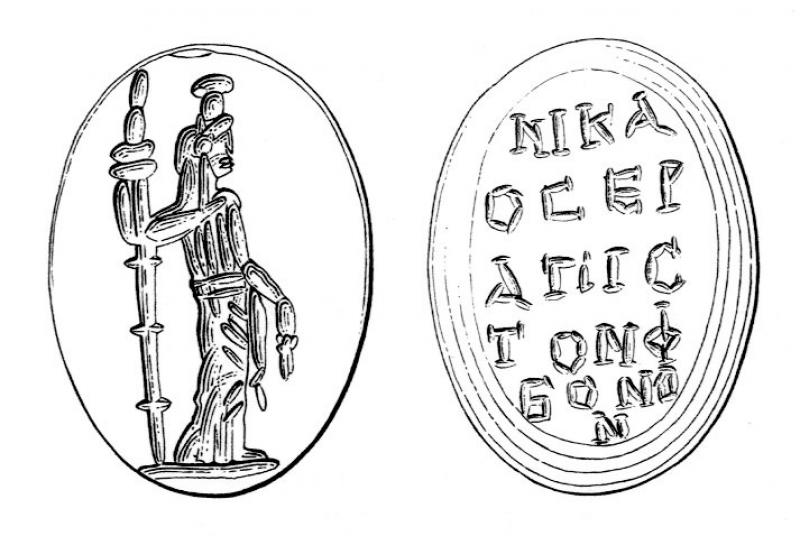Bonner, SMA, 176.
monotheism is scarcely to be found in them; and the term “henotheistic,” sometimes applied to them, is misleading unless accepted in a broad sense, namely, that one divinity, whether single or of plural personality, chosen and elevated to a position of preëminence in the religious feeling of some group of worshipers — group which may be ethnic, religious, or bound together by some tie of social affinity or common economic interest.
The victory acclamation, usually in the form νικᾷ ὁ δεῖνα, “So-and-So conquers,” has both secular and religious applications. Examples of the latter, which alone concern us, have been gathered and adequately discussed by Drexler, Weinreich, and Peterson.65 Three unpublished examples may be added to their lists. One, νικᾷ ἡ Εἶσις, is engraved, strangely enough, on the reverse of a stone representing, not Isis, but Harpocrates standing and holding a cornucopia.66 These words also occur on the reverse of a Michigan stone, the obverse of which bears the common design of a head of Sarapis over an eagle with raised wings.67 A formula which has not been previously recorded, νικᾷ ὁ ἐπήκοος, “Victorious is the god who listens to prayers,” is engraved on the reverse of a blue glass paste, the obverse side of which shows Sarapis enthroned, between Isis and Nephthys, who stand facing towards him, one on each side.68 The design closely resembles a black glass paste in the Petrie collection which has the reverse inscription νικᾷ ἡ Εἶσις.69
The epithet ἐπήκοος was applied to various divinities in Oriental cults; the eastern influence is abundantly demonstrated by Weinreich in his article Θεοὶ Ἐπήκοοι, which uses and greatly enlarges the collections of Drexler and others.70 Examples of ἐπήκοος as an epithet of Sarapis are not numerous, but among them there is a very important one, the dedicatory inscription θεῷ ἐπηκόῳ Σαράπιδι on the architrave of the temple of Sarapis at Miletus (third century after Christ).71 Another example of ἐπήκοος in a glyptic text occurs in the reverse inscription of an important gem now loaned to the Brooklyn Museum by the New York Historical Society; its face represents the lion god of Leontopolis (D. 283). The legend as a whole to be examined later (p. 184); here it is enough to cite the clause σὺ εἶ. . .ὁ ἐπήκοος θεός.
There is a special application of the victory formula in a British Museum specimen which is inscribed on the back νικᾷ ὁ Σέραπις τὸν φθόνον, “Sarapis overcomes the evil eye.”72 This is another example of discrepancy between an inscription and the accompanying design; for the obverse shows not Sarapis, but a fully draped goddess standing, a modius on her head and a tall scepter in the right hand; perhaps Isis.
To the μέγας acclamations previously published the present work can add nothing of importance. The numerous examples of μέγα τὸ ὄνομα τοῦ Σάραπις may be conveniently examined in Peterson's work.73 μέγα τὸ ὄνομα
65 Drexler, Woch. klass. Phil., 1886, p. 1433; Weinreich, Neue Urkunden zur Sarapis-Religion, pp. 33 f., Peterson, op. cit., pp. 152–163.
68 D. 19.
69 Amulets, Pl. 21, 135a.
70 In Athen. Mitt., 37 (1912), 1–68.
71 Ibid., p. 18, No. 84.
72 B. M. 56161; King, Gnostics, Pl. E 4.
73 Peterson, op. cit., p. 208.
Last modified: 2012-11-05 11:24:20
Link: cbd.mfab.hu/pandecta/1621


